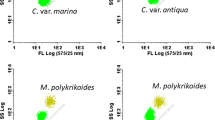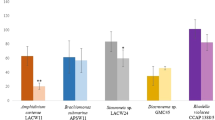Abstract
This study investigated the possible roles of superoxide produced by raphidophyte and prymnesiophyte microalgae as an ichthyotoxic agent to damselfish and an allelopathic agent to bacteria. We found that the rate of superoxide production varied with algal cell density, with cell densities of the raphidophyte Chattonella marina >10,000 cells ml−1 producing less environmental levels of superoxide per cell (94±14 chemiluminescence units) than cell densities <10,000 cells ml−1 (390±54 units per cell). Microalgal cells have the capacity to change their superoxide production rate over a period of 1 h, dependent on cell density and metabolic activity. We also examined the effect of superoxide on suppression of bioluminescence of the marine bacterium Vibrio fischeri as a model for bacterial alleopathy and found that both superoxide and free fatty acids such as eicosapentaenoic acid (EPA; 20:5ω3) present in raphidophyte microalgal cells cause suppression of bacterial bioluminescence. The combination of superoxide in the presence of EPA further enhanced bioluminescence suppression. Superoxide was also found to enhance the toxicity of free fatty acid EPA to damselfish (Acanthochromis polycanthus) at concentrations as low as 0.2 mg l−1. In conclusion, consideration should be given to density dependent and/or metabolic variations of toxicity when publishing minimum alert levels for superoxide producing ichthyotoxic microalgal species. A secondary role of superoxide production may be to enhance the toxicity of algal exudates or serve as an allelopathic agent against bacterial fouling.







Similar content being viewed by others
References
Aldsworth TG, Sharman RL, Dodd CER, Stewart GSAB (1998) A competitive microflora increases the resistance of Salmonella typhimurium to inimical processes: evidence for a suicide response. Appl Environ Microbiol 64:1323–1327
Arzul G, Gentien P, Bodennec G, Toularastel F, Youenou A, Crassous MP (1995) Comparison of toxic effects of Gymnodinium cf. nagasakiense polyunsaturated fatty acids. In: Lassus P, Arzul G, Erard E, Gentien P, Marcaillou C (eds) Harmful marine algal blooms. Lavoisier, Paris, pp 395–400
Arzul G, Bodennec G, Gentien P, Bornens P, Crassous M-P (1998) The effect of dissolved oxygen on the haemolytic property of Gymnodinium ichthyotoxins. In: Reguera B, Blanco J, Fernandez ML, Wyatt T (eds) Harmful algae. Xunta de Galicia and Intergovernmental Oceanographic Commission of UNESCO, Vigo, pp, 611–614
Atlas RM, Parks LC (ed) (1993) Handbook of microbiological media. CRC Press, Boca Raton, Fla., pp 711–712
Bancroft JD, Stephens A (eds) (1990) Theory and practice of histopathological techniques, 3rd edn. Churchill Livingstone, UK
Bielski BHJ, Cabelli DE, Arudi RL (1985) Reactivity of HO2/O2− radicals in aqueous solution. J Phys Chem Ref Data 14:1041–1100
Blackburn SI, Hallegraeff GM, Bolch CJ (1989) Vegetative reproduction and sexual life cycle of the toxic dinoflagellate Gymnodinium catenatum from Tasmania, Australia. J Phycol 25:577–590
Cabiscol E, Tamarit J, Ros J (2000) Oxidative stress in bacteria and protein damage by reactive oxygen species. Int Microbiol 3:3–8
Dodd CER, Aldsworth TG (2002) The importance of RpoS in the survival of bacteria through food processing. Int J Food Microbiol 74:189–194
Dodd CER, Sharman RL, Bloomfield SF, Booth IR, Stewart GSAB (1997) Inimical processes: bacterial self-destruction and sub-lethal injury. Trends Food Sci Technol 8:238–241
Ferreira JT, Schoonbee HJ, Smit L (1984) The uptake of the anaesthetic benzocaine hydrochloride by the gills and the skin of three freshwater fish species. J Fish Biol 25:35–41
Fulladosa E, Murat JC, Martine M, Villaescusa I (2004) Effect of pH on arsenate and arsenite toxicity to luminescent bacteria (Vibrio fischeri). Arch Environ Contam Toxicol 46:176–182
Halliwell B, Gutteridge JMC (1999) Free radicals in biology and medicine. Oxford University Press, London
Ishimatsu A, Oda T, Yoshida M, Ozaki M (1996) Oxygen radicals are probably involved in the mortality of yellowtail by Chattonella marina. Fish Sci 62:836–837
Jenkinson IR, Arzul G (2001) Mitigation by cysteine compounds of rheotoxicity, cytotoxicity and fish mortality caused by the dinoflagellates, Gymnodinium mikimotoi and G. cf. maguelonnense. In: Hallegraeff GM, Bolch CJS, Blackburn SI, Lewis R (eds) Harmful algal Blooms 2000. UNESCO, Paris, pp 461–464
Juttner F (2001) Liberation of 5, 8, 11, 14, 17-eicosapentaenoic acid and other polyunsaturated fatty acids from lipids as a grazer defence reaction in epilithic diatom biofilms. J Phycol 37:744–755
Kim CS, Lee SG, Lee CK, Kim HG, Jung J (1999) Reactive oxygen species as causative agents in the ichthyotoxicity of the red tide dinoflagellate Cochlodinium polykrikoides. J Plank Res 21:2105–2115
Marshall JA, Hovenden M, Oda T, Hallegraeff GM (2002) Photosynthesis does influence reactive oxygen species production in the red tide alga Chattonella marina (Raphidophyceae). J Plank Res 142:1231–1236
Marshall JA, Nichols PD, Hamilton B, Lewis RJ, Hallegraeff GM (2003) Ichthyotoxicity of Chattonella marina (Raphidophyceae) to damselfish (Acanthochromis polycanthus): the role of reactive oxygen species and free fatty acids. Harmful Algae 2:273–281
Marshall JA, de Salas M, Oda T, Hallegraeff G (2005) Superoxide Production by Marine Microalgae. I. Survey of 37 Species from 6 classes. Mar Biol (in press)
Matsuyama Y, Uchida T, Kotani Y (2000) Effect of culture filtrate of raphidophytes Heterosigma akashiwo and Chattonella antiqua on the growth of diatom Skeletonema costatum Bull Fish Environ Inland Sea 2:57–66 (In Japanese, English abstract)
Oda T, Moritomi J, Kawano I, Hamaguchi S, Ishimatsu A, Muramatsu T (1995) Catalase- and superoxide dismutase-induced morphological changes and growth inhibition in the red tide phytoplankton Chattonella marina. Biosci Biotech Biochem 59:2044–2048
Oda T, Nakamura A, Midori S, Kawano I, Ishimatsu A, Muramatsu T (1997) Generation of reactive oxygen species by raphidophycean phytoplankton. Biosci Biotech Biochem 61:1658–1662
Okaichi T, Ochi T, Nishio S, Takano H, Matsuno K, Morimoto T, Murakami T, Shimada M (1989) The cause of fish kills associated with red tides of Chattonella antiqua (Hada) Ono. Curr Top Mar Biotechnol 58:185–188
Onorati F, Mecozzi M (2004) Effects of two diluents in the Microtox toxicity bioassay with marine sediments. Chemosphere 54:679–687
Pratt DM (1966) Competition between Skeletonema costatum and Olisthodiscus luteus in Naragansett Bay and in culture. Limnol Oceanogr 11:447–455
Sandvik SL, Bilski P, Pakulski JD, Chignell CF, Coffin RB (2000) Photogeneration of singlet oxygen and free radicals in dissolved organic matter isolated from the Mississippi and Atchafalaya River plumes. Mar Chem 69:139–152
Singleton P, Sainsbury D (2001) Dictionary or microbiology and molecular biology. Wiley, Chichester, UK
Tang JYM, Au DWT (2004) Osmotic distress is a probable cause of fish kills upon exposure to a sub-bloom concentration of the toxic algal Chattonella marina. Environ Toxicol 23 (in press)
Verity PG, Stoeker D (1982) Effects of Olisthodiscus luteus on the growth and abundance of tintinnids. Mar Biol 72:79–87
Acknowledgements
We thank the following people from the University of Tasmania: Quinn Fitzgibbon and Professor Ned Pankhurst from the School of Aquaculture for the culture of the damsel fish, the late Dr. Barry Munday of the School of Biomedical Science for advice on fish pathology, Helen Bond of the School of Plant Science for algal culturing assistance, Dr. Jenny Skerratt of the School of Agricultural Science for providing the V. fischeri isolate and assistance with bacterial culture techniques, Dr. Peter Nichols of CSIRO Marine Research for encouragement and reviewing the manuscript, and Professor William Cooper of the University of North Carolina, Wilmington for assistance with ROS literature. This work was partially supported by an Australian Research Council grant. Experiments were carried out under the auspices of the University of Tasmania Ethics application no. A0006359.
Author information
Authors and Affiliations
Corresponding author
Additional information
Communicated by M.S. Johnson, Crawley
Rights and permissions
About this article
Cite this article
Marshall, JA., Ross, T., Pyecroft, S. et al. Superoxide production by marine microalgae. Marine Biology 147, 541–549 (2005). https://doi.org/10.1007/s00227-005-1597-6
Received:
Accepted:
Published:
Issue Date:
DOI: https://doi.org/10.1007/s00227-005-1597-6




